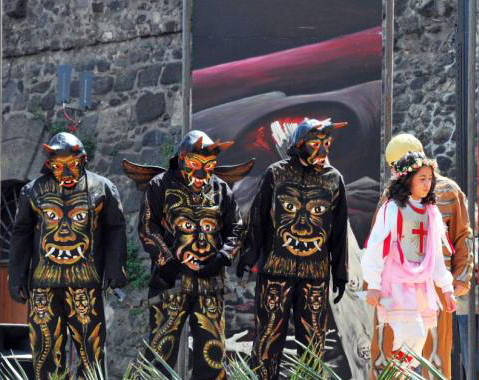Easter at Adrano in the province of Catania in Sicily, is focused around the Diavolata, which is a performance of a centuries-old religious play. Written in 1752 by Don Anselmo Laudani, a brother in a nearby religious order, it is performed on the evening of Easter Sunday.
The Diavolata acts out the eternal battle between good and evil. The central part of the drama focuses on the struggle between several devils and St. Michael the Archangel, who not only manages to defeat the evil doers, but also gets them to praise God.
On Easter morning, the three statues of the Savior, the Madonna and St. Michael the Archangel are carried through the city. In the central piazza, a stage is erected and divided into two parts: one devoted to hades, inhabited by the devil and five demons, while the other side of the stage represents heaven. The drama is staged by local actors who pass on from father to son, the gestures and verses of the play. The devils try to convince humanity to remain damned because Jesus Christ (who is risen), is no longer in the tomb, but the Archangel Michael intervenes, ultimately making the demons say the words, “Viva Maria.”
The second part of the drama, L’Angelicata follows. This is the meeting between Mary and Jesus and takes place in front of the Church of Santa Chiara, the so-called “Peace.” Also written by Don Laudani, it has only been staged since 1980. It takes the form of a teenaged girl, dressed as an angel, who slides down a zip line to meet the statue of the newly resurrected Christ. The young woman then welcomes Christ with a short speech and prayer to the thunderous cheers of the crowd, followed by fireworks.





